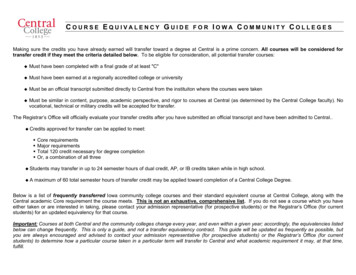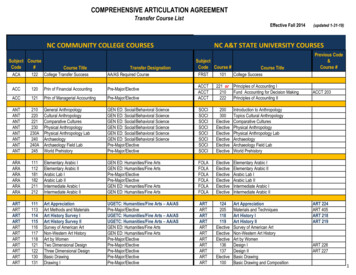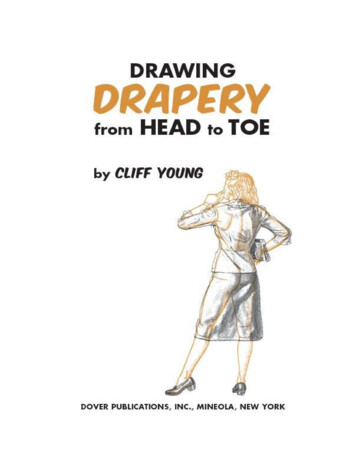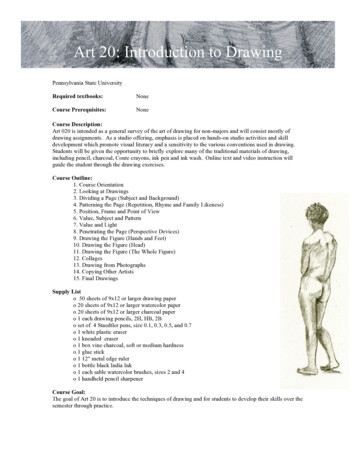
Transcription
Art 20: Introduction to DrawingPennsylvania State UniversityRequired textbooks:NoneCourse Prerequisites:NoneCourse Description:Art 020 is intended as a general survey of the art of drawing for non-majors and will consist mostly ofdrawing assignments. As a studio offering, emphasis is placed on hands-on studio activities and skilldevelopment which promote visual literacy and a sensitivity to the various conventions used in drawing.Students will be given the opportunity to briefly explore many of the traditional materials of drawing,including pencil, charcoal, Conte crayons, ink pen and ink wash. Online text and video instruction willguide the student through the drawing exercises.Course Outline:1. Course Orientation2. Looking at Drawings3. Dividing a Page (Subject and Background)4. Patterning the Page (Repetition, Rhyme and Family Likeness)5. Position, Frame and Point of View6. Value, Subject and Pattern7. Value and Light8. Penetrating the Page (Perspective Devices)9. Drawing the Figure (Hands and Feet)10. Drawing the Figure (Head)11. Drawing the Figure (The Whole Figure)12. Collages13. Drawing from Photographs14. Copying Other Artists15. Final DrawingsSupply Listo 50 sheets of 9x12 or larger drawing papero 20 sheets of 9x12 or larger watercolor papero 20 sheets of 9x12 or larger charcoal papero 1 each drawing pencils, 2H, HB, 2Bo set of 4 Staedtler pens, size 0.1, 0.3, 0.5, and 0.7o 1 white plastic erasero 1 kneaded erasero 1 box vine charcoal, soft or medium hardnesso 1 glue sticko 1 12" metal edge rulero 1 bottle black India Inko 1 each sable watercolor brushes, sizes 2 and 4o 1 handheld pencil sharpenerCourse Goal:The goal of Art 20 is to introduce the techniques of drawing and for students to develop their skills over thesemester through practice.
Course Objectives:By the end of the course the student will be able to:o Work in pencil, ink pen, ink wash, charcoal and collageo Create a fully rendered drawing with detail and shadowo Closely observe and document one’s surroundingsCourse Delivery Format:This course will be delivered entirely online. Questions and assistance may be obtained by contacting theInstructor or the Teaching Assistant. Please pay attention to who grades your work and direct all questionsto the appropriate person.Technical Requirements Access to a digital camera. If you are attending University Park and do not have access to a digitalcamera, you can check one out at the Media and Technology Support Services located at 26Willard Building. MTSS now has a second location at the Wagner Annex. You will be allowed tocheck it out only for a few days at a time. Cell phone cameras are discouraged because of theirgenerally poor resolution.Media Technology Support Services26 Willard Building and Wagner /index.htmlComputer with Internet accessPhoto editing software (available through computer labs or by online tools as explained in thecourse orientation)Since this is an online course, you must have the ability to access the Internet; you may use any one of thefollowing browsers:o Netscape 9 or latero Firefox 2.0 or latero Safari (Mac) 3.0 or laterNote: Please make sure that your Web browser has been set to enable JavaScript.Other technical requirements for this course include:o Adobe Flash Player 9 or latero A minimum of 128 MB of RAMo 1GB of available (a.k.a "free") hard disk storage is recommendedo 56K modem or broadband connection (cable modem, DSL, or LAN)Course Grading ScaleThe grading scale used in Art 20 is the standard scale used in all studio-based courses. The gradedistribution is as follows:A 92% to 100% (EXCELLENT)Exceptional work, pushing the limits of the assignment and challenging yourself, artwork isexecuted with creativity and attention to detail.A- 90% to 91%B 89%B 82% to 88% (GOOD)Quality work, well done, executed with care and attentiveness.B- 80% to 81%
C 79%C 70% to 78% (SATISFACTORY)Average work, assignment guidelines were properly followed, acceptable, and satisfactoryachievement.D 60% to 69% (POOR)Inferior work, barely meets assignment requirements, no effort or time invested.F less than 60% (FAILURE)Work does not meet the minimum requirement. Incomplete work.Please note that it's better to submit something than nothing. Even if you get 5 out of 25 it will stillhelp your grade. Not submitting an assignment will give you a 0.AssignmentsThe table below summarizes the assignments you are required to complete in this course by type, quantity,and point value. Directions for each of the assignments can be downloaded from within each of the courselessons. Additionally, submission directions and grading rubrics can be found from within thedownloadable assignment documents.Assignment TypeQuantity x ValuePointsIntroduction ActivityOrientation QuizLooking at Pictures QuizPractice DrawingsDrawing AssignmentsFinal Drawing Assignments(1 @ 25)(1 @ 25)(1 @ 50)(24 @ 25)(12 @ 50)(2 @ 100)252550600600200Course Total1500 PointsIn addition, there will be a 25 point extra-credit assignment for anyone who feels they need a boost. Youwill find the information for that during the last week of the course, and it should not be done until the lastweek of the course so that you have enough experience before trying it.
Calendar It is essential that all due dates are adhered to, as late assignments will not be accepted and amissing week of assignments will severely affect your grade. If you experience technical difficulties, try only three times to submit via the website. If itdoes not work after three attempts, then email the assignment to the instructor before youget utterly frustrated. Explain the technical problem in the email. If the email is timestamped within the due date then you will receive full consideration. Allow a minimum of 48 hours after an assignment due date (48 hours on Weeks 3-12, wait24 hours on week 2) has passed before contacting your instructor about grading status. Yourinstructor will strive to provide you with feedback in a timely fashion.Week 1Due Date and TimeComplete Introduction ActivityTuesday At 11:59 pmLesson 1: OrientationComplete Lesson 1 in the Lesson Outline (course Web pagetext/video)Complete Orientation QuizThursday at 11:59 pmLesson 2: Looking at DrawingsComplete Lesson 2 in the Lesson OutlineComplete Looking at Drawings QuizSunday at 11:59 pmWeek 2Due Date and TimeLesson 3: Dividing a Page (Subject and Background)Complete Lesson 3 in the Lesson OutlineSubmit Practice Drawings 3.1 and 3.2Tuesday at 11:59pmSubmit Drawing Assignment 3Thursday at 11:59 pmLesson 4: Patterning the Page (Repetition, Rhyme, and FamilyLikeness)Complete Lesson 4 in the Lesson OutlineSubmit Practice Drawings 4.1 and 4.2Friday at 11:59pmSubmit Drawing Assignment 4.3Sunday at 11:59 pmWeek 3Due Date and TimeLesson 5: Position, Frame and Point of ViewComplete Lesson 5 in the Lesson OutlineSubmit Practice Drawings 5.1 and 5.2Wednesday at 11:59pmSubmit Drawing Assignment 5.3Sunday at 11:59 pmWeek 4Due Date and TimeLesson 6:Value, Subject and Pattern
Complete Lesson 6 in the Lesson OutlineSubmit Practice Drawings 6.1 and 6.2Wednesday at 11:59pmSubmit Drawing Assignment 6.3Sunday at 11:59 pmWeek 5Due Date and TimeLesson 7: Value and LightComplete Lesson 7 in the Lesson OutlineSubmit Practice Drawings 7.1 and 7.2Wednesday at 11:59pmSubmit Drawing Assignment 7.3Sunday at 11:59 pmWeek 6Due Date and TimeLesson 8: Penetrating the Page (Perspective Devices)Complete Lesson 8 in the Lesson OutlineSubmit Practice Drawings 8.1 and 8.2Wednesday at 11:59pmSubmit Drawing Assignment 8.3Sunday at 11:59 pmWeek 7Due Date and TimeLesson 9: Drawing the Figure (Hands and Feet)Complete Lesson 9 in the Lesson OutlineSubmit Practice Drawings 9.1 and 9.2Wednesday at 11:59pmSubmit Drawing Assignment 9.3Sunday at 11:59 pmWeek 8Due Date and TimeLesson 10: Drawing the Figure (Head)Complete Lesson 10 in the Lesson OutlineSubmit Practice Drawings 10.1 and 10.2Wednesday at 11:59pmSubmit Drawing Assignment 10.3Sunday at 11:59 pmWeek 9Due Date and TimeLesson 11: Drawing the Figure (The Whole Figure)Complete Lesson 11 in the Lesson OutlineSubmit Practice Drawings 11.1 and 11.2Wednesday at 11:59pmSubmit Drawing Assignment 11.3Sunday at 11:59 pmWeek 10Due Date and TimeLesson 12: CollagesComplete Lesson 12 in the Lesson Outline
Submit Practice Drawings 12.1 and 12.2Wednesday at 11:59pmSubmit Drawing Assignment 12.3Sunday at 11:59 pmWeek 11Due Date and TimeLesson 13: Drawing from PhotographsComplete Lesson 13 in the Lesson OutlineSubmit Practice Drawings 13.1 and 13.2Wednesday at 11:59pmSubmit Drawing Assignment 13.3Sunday at 11:59 pmWeek 12Due Date and TimeLesson 14: Copying Other ArtistsComplete Lesson 14 in the Lesson OutlineSubmit Practice Drawings 14.1 and 14.2Wednesday at 11:59pmSubmit Drawing Assignment 14.3Sunday at 11:59 pmSubmit Extra Credit Assignment (optional)Sunday at 11:59 pmFinalsNote: Drawings due Friday instead of SundayDue Date and TimeLesson 15: Final DrawingsComplete Lesson 15 in the Lesson OutlineSubmit Final Drawings-Last day of classFriday at 11:59 pmAcademic Integrity:According to the Penn State Principles and University Code of Conduct:Academic integrity is a basic guiding principle for all academic activity at Penn StateUniversity, allowing the pursuit of scholarly activity in an open, honest, and responsiblemanner. In according with the University’s Code of Conduct, you must not engage in ortolerate academic dishonesty. This includes, but is not limited to cheating, plagiarism,fabrication of information or citations, facilitating acts of academic dishonesty by others,unauthorized possession of examinations, submitting work of another person, or workpreviously used without informing the instructor, or tampering with the academic work ofother students.Any violation of academic integrity will be investigated, and where warranted, punitive action will betaken. For every incident when a penalty of any kind is assessed, a report must be filed.Affirmative Action & Sexual Harassment:The Pennsylvania State University is committed to a policy that all persons shall have equal access toprograms, facilities, admission, and employment without regard to personal characteristics not related toability, performance, or qualifications as determined by University policy or by Commonwealth or Federalauthorities. Penn State does not discriminate against any person because of age, ancestry, color, disabilityor handicap, national origin, race, religious creed, sex, sexual orientation, or veteran status. Direct allinquiries to the Affirmative Action Office, 211 Willard Building.
An Invitation to Students with Learning Disabilities:It is Penn State’s policy to not discriminate against qualified students with documented disabilities in itseducational programs. If you have a disability-related need for modifications in your testing or learningsituation, your instructor should be notified during the first week of classes so that your needs can beaccommodated. You will be asked to present documentation from the Office of Disability Services(located in 116 Boucke Building, 863-1807) that describes the nature of your disability and therecommended remedy. You may refer to the Nondiscrimination Policy in the Student Guide to UniversityPolicies and Rules.Good Netiquette:Although the course is offered online, and there is no face to face interaction between you and theinstructor of the course, communication through email is highly encouraged to address any and allquestions or concerns that you may have with the course.The following points should be remembered when emailing in an online environment: Introduce yourself - use your first and last name Clearly state your reason for contacting them If you are responding to an email, include the message to which you are replying Before forwarding someone's email, ask for permission Review/re-read the message to ensure the message is clear and the intent is appropriate Be Professional - treating the professor with professionalism and respect will enable them torespond to you with the same courtesy.Additional tips include: Selecting your words carefully Spell Check messages before sending them Refrain from using emoticons Refrain from using all Capital letters, it gives the impression you're SHOUTING! Remember to zip large files before sending them
Students will be given the opportunity to briefly explore many of the traditional materials of drawing, including pencil, charcoal, Conte crayons, ink pen and ink wash. Online text and video instruction will guide the student through the drawing exercises. Course

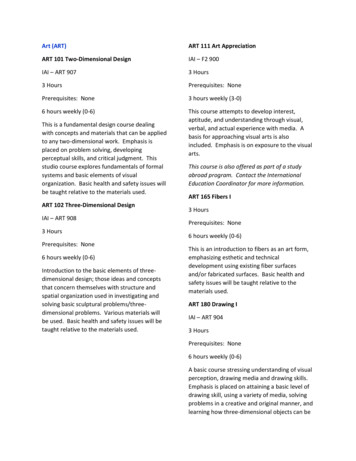




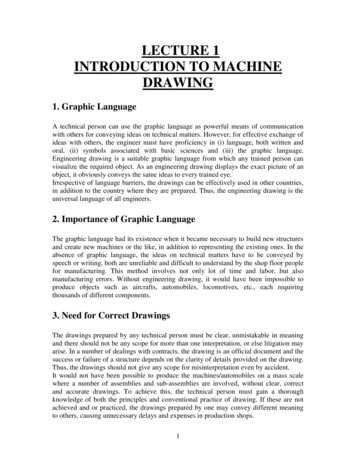
![Drawing the Human Head Burne Hogarth[English] - Internet Archive](/img/29/drawing-the-human-head-burne-hogarth-english.jpg)

